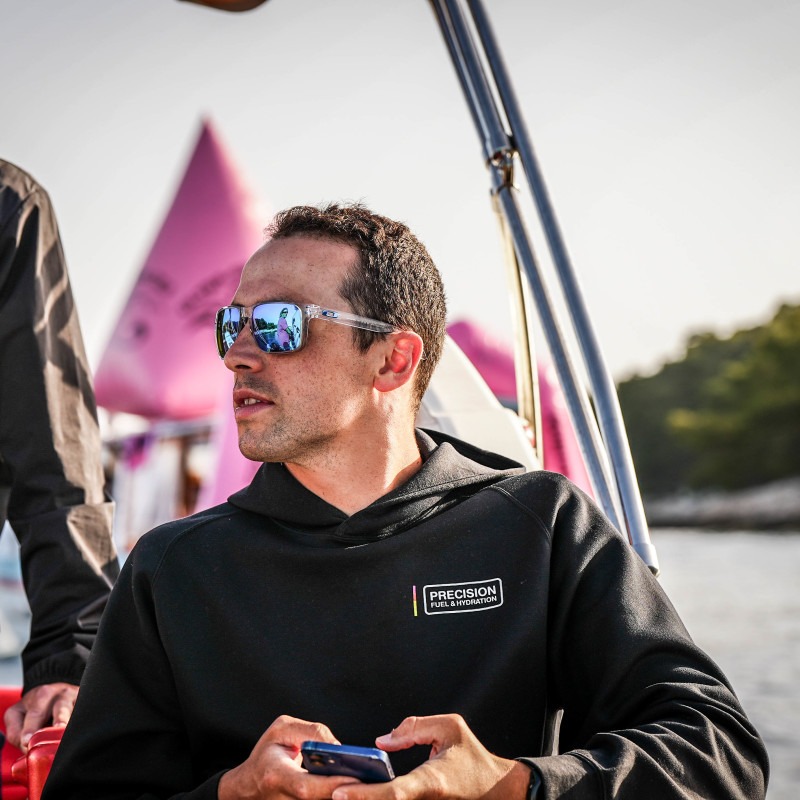
Chris Harris
UltraSwim 33.3
Chris' headline numbers
Chris' strategy
Fueling
Carbohydrate is the main fuel you burn when racing. Failing to fuel properly is a leading cause of underperformance in longer races.
This unique race involved swimming 33.3km (20.6 miles) across five swims in four days, with stages ranging from 4.6km to 11.3km (2.8 - 7 miles). Minty knew pre-fueling would be much more important during these relatively “shorter” swims compared to his usual IRONMAN® distance races, so took a PF 30 Caffeine Gel 45 minutes prior, and a PF 30 Gel 10 minutes before each stage. This was Minty’s first open-water swim race, so his preparation involved a few more ‘firsts’. Most notably, he’d never fuelled during a swim before, which challenges the stomach more than other sports, because gravity can’t assist with digestion due to the body being horizontal. Thankfully, by implementing some targeted gut training into his weekly swim practices (where he simulated taking 100-120g per hour during some pool swims), Minty was able to comfortably consume up to ~89g/h during the longest swim. He did this by carrying some PF 30 Caffeine Gels in his wetsuit sleeves, which he then pulled out whilst swimming, rolling onto his back and consuming it as quickly as possible, before tucking the empty wrapper back into his wetsuit and resuming swimming. He also picked up some additional Gels and Carb Only Drink Mix from the aid station boats which were positioned every ~4km (2.5 miles).
Hydration
Taking on board an appropriate amount of fluid and sodium is essential to maintaining blood volume and supporting the cardiovascular effort needed to perform on race day.
Whilst the absolute amount of sodium and fluid consumed per hour is important, it’s critical to consider these in relation to each other. This is known as 'relative sodium concentration' and it’s expressed in milligrams per litre (mg/L). How much sodium you’re taking in per litre of fluid is more important than the absolute amount taken in per hour.
Sweat sodium concentration (mg/L) is largely genetically determined and remains relatively stable. Knowing how salty your sweat is enables you to replace a good proportion of your sweat losses, which can range from 200-2,000mg/L.
Given Chris’s losses are Very High (1,433mg/L), nailing his hydration strategy becomes especially crucial when it’s hot and/or humid.
Learn moreBy weighing himself before and after each swim, Minty was confidently able to calculate his sweat rate. Even in the ~18℃ / 64℉ water, where he felt quite cold at times, he was losing between ~0.88 and ~1.25L (~30 - 44oz) per hour. Because of this, by pre-hydrating optimally, he wouldn’t have crossed the generally accepted threshold for dehydration during the swims. By bookending his days with a bottle of PH 1500, Minty likely prepared and recovered from each swim adequately. Further, he was able to sprint-finish each stage without cramps or other dehydration-related symptoms, reinforcing his confidence in his hydration strategy.
Caffeine
Beyond the Three Levers of Performance (carb, sodium and fluid), caffeine is one of only a few substances that is proven to improve performance for most endurance athletes as it can help stave off mental and physical fatigue.
Minty prepared for every swim with a PF 30 Caffeine Gel ~45 minutes before the start, and a regular PF 30 Gel within the last 10-15 minutes. During the longer swims (8.2k and 11.3k) he took Caffeine Gels every hour to top up his blood caffeine levels. He really felt the ergogenic effects of this - particularly when swimming for several hours in one go - and Minty reported no lapses in concentration, which is one of the key benefits of using the stimulant during endurance exercise. One moment of note was when the group Minty was swimming started to swim off-course. Realising this, and reacting immediately to correct his sat-nav, meant he gapped his rivals by almost two minutes by the finish line, which he puts down to just being “more focused in the moment”. It’s also worth noting that Minty’s caffeine intake was spread out over four days, allowing for plentiful metabolism overnight, and likely fell well within the recommended dose for single-day events.
How Chris hit his numbers
Here's everything that Chris ate and drank on the day...
Chris' weapons of choice
Final thoughts
Chris' full stats
Data Confidence?
There is good confidence in the accuracy of the data reported. An athlete feels that the numbers closely reflect what they consumed despite a couple of estimations which may carry some degree of error. The majority of what was consumed is recorded to a high level of specificity (most volumes are known through the use of bottles brands quantities flavours). The numbers are very plausible and align with previous data recordings (if an athlete has collected data previously).